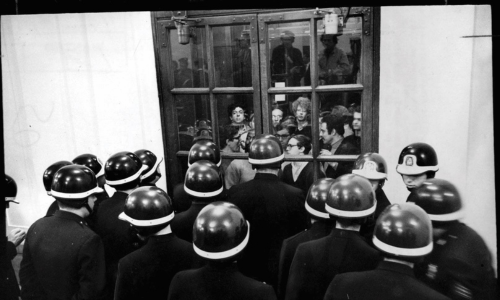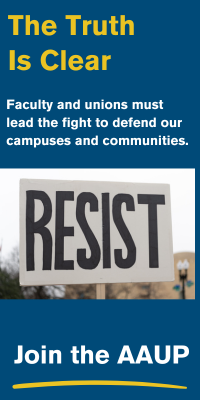- About
- Programs
- Issues
- Academic Freedom
- Political Attacks on Higher Education
- Resources on Collective Bargaining
- Shared Governance
- Campus Protests
- Faculty Compensation
- Racial Justice
- Diversity in Higher Ed
- Financial Crisis
- Privatization and OPMs
- Contingent Faculty Positions
- Tenure
- Workplace Issues
- Gender and Sexuality in Higher Ed
- Targeted Harassment
- Intellectual Property & Copyright
- Civility
- The Family and Medical Leave Act
- Pregnancy in the Academy
- Publications
- Data
- News
- Membership
- Chapters
In the Shadow of Vietnam
How the Vietnam War has shaped our moment.

When the genocide against Palestinians began, I said to a friend that the last time we saw mass destruction televised on this scale was during the Vietnam War. The parallels are striking. In addition to the televised nature of the massacres, the assault on Gaza and the Vietnam War both prompted young people to decry the unimaginable scale of the slaughter and the complicity of the United States in it. In both historical moments students exposed the American university’s interests in the military-industrial complex. And in both cases, university administrations used the police to suppress campus struggles. Today’s student struggles reveal that we are still in the shadow of Vietnam.
Understanding the significance of the Vietnam-era protests and the ones taking place now means looking back to World War II, when the bombing of cities and the killing of civilians first became a strategy of war. Prior to World War II, war was primarily fought on the ground, and soldiers were its primary casualties. As war increasingly became an aerial drama with planes and bombs, civilians were increasingly among the ranks of the dead.
As the historian Linda R. Robertson notes, this shift toward bombing cities and making civilians shoulder the burdens of war’s atrocities was a deliberate and new military strategy. She states, “The threatened aerial bombardment of cities would serve a civilizing function as a deterrent for future wars, while strategic bombing in the event of war would also civilize the violence of modern warfare by [en]suring that wars were short and decisive.” For military strategists, targeting cities would send a message, severely and quickly, to the population at large: “The idea of strategic bombing,” Robertson writes, “was legitimated among military analysts because the civilian population was assigned the key responsibility for starting and ending wars.”
The twentieth century’s most tragic and colossal wars have emerged from this shift in strategy. Hundreds of thousands of civilians were killed and injured because of the bombings of Hiroshima and Nagasaki. Several million people were killed during the Korean War. Even more were maimed. US naval and air forces engaged in “saturation bombings” of cities in North Korea, turning them into rubble. In 1950, the United States bombed communities in South Korea, suspecting them of harboring North Korean infiltrators. The bombing of the Iri railway station, for instance, resulted in the killing of three hundred civilians. US warplanes strafed multiple regions in South Korea, massacring scores of civilians. When a British journalist saw the number of North Korean towns that had been annihilated and the number of people who died in the ashes of their homes, he reported, “It was far worse than the worst the Nazis ever did.”
The shift toward civilian targets would take on an alarming specificity. The Save the Children Foundation has reported that “close to 90 percent of war casualties now are civilians, the majority of whom are women and children. This compares to 5 percent a century ago.” By targeting civilian populations for the purpose of deterrence and punishing them for their leaders’ actions, modern warfare takes aim at the future of entire populations and the people historically tasked with producing and nurturing that future.
For many, the Vietnam War made the genocidal implications of this shift clearer than preceding wars. As the political theorist Eqbal Ahmad wrote, “The war in Vietnam laid to rest the Third World’s illusions about the United States.” In particular, the war disabused people in the Global South of the notion that the United States—a nation born of anticolonial revolution—was committed to the emancipation of the colonized. As Vietnamese civilians were made targets of war, the image of the United States as guardian of the world and keeper of democracy would be blown to smithereens as well.
Moreover, the war would put US foreign policy on trial in the court of global opinion. Placing US foreign policy in historical context, Ahmad argued, “Since 1945, United States forces have engaged more frequently, lost more lives, inflicted more suffering, and expended greater amounts of arms and money in suppressing social revolutions in poor countries than they have in defending America’s security from enemies or rivals.” Instead of promoting democracy, US foreign policy emerged in this period as the route for weapons distribution and, hence, instability in much of the world. Ahmad observed, for instance, “Between 1947 and 1970, as America stood ‘watch,’ in the ringing phrase of John F. Kennedy, ‘over the walls of world freedom,’ Washington intervened against local revolutions and nationalist regimes . . . an average of once every sixteen months. During this period, the United States spent more than fifty times more money on its military operations in underdeveloped countries than on its so-called economic aid to them.” The image of the United States as the world’s philanthropist was replaced by an understanding of the country as the planet’s war profiteer.
People in the Global South were not the only ones to lose their innocence about the nation’s role in the world. Young Americans would suffer an ideological shock as well. In a 1966 position paper on Vietnam, the Student Nonviolent Coordinating Committee (SNCC) asserted that it had “a right and a responsibility to dissent with United States foreign policy on any issue when it sees fit,” citing US deception about the nation’s role in Vietnam as well as the government’s claim to be a defender of “freedom for colored people in such other countries as the Dominican Republic, the Congo, South Africa, Rhodesia and in the United States itself.” Noting the United States’s relationship to liberation movements in other parts of the world, SNCC—like Ahmad—argued, “We maintain that our country’s cry of ‘preserve freedom in the world’ is a hypocritical mask behind which it squashes liberation movements which are not bound, and refuse to be bound, by the expediencies of United States Cold War policies.”
The position paper continued by spelling out the link between US-style democracy and militarization. “We recoil with horror,” the students said, “at the inconsistency of a supposedly ‘free’ society where responsibility to freedom is equated with the responsibility to lend oneself to military aggression.” By illustrating how the government sutured freedom to militarization, SNCC exposed the contradictions of the United States as the great champion of democracy and its role as the largest weapons distributor in the world.
Two years after SNCC’s position paper, the American peace activist Dave Dellinger published a 1968 article in Liberation about the proceedings of the International War Crimes Tribunal held in Denmark in 1967. He said, “As the Tribunal moved its searchlight from North to South Vietnam and on to Laos, Thailand, and Cambodia, there emerged a pattern of gradually escalating contempt for Asian life and dignity and a resulting scale of death and destruction that stuns the imagination and legitimizes—nay requires—use of the term genocide. Significantly, former G.I.’s Matinsen and Tuck indicated that they were content to kill ‘Communists’ in Vietnam but that their disillusionment began when they discovered that the entire Vietnamese population was subject to attack unless they left their native homesteads and moved into the U.S.-occupied areas.”
As Dellinger’s reporting suggests, the Vietnam War was both a racial and a colonial project, one involving the construction of the Vietnamese as communist threats and the establishment of occupied territories. Dellinger’s observations and those of SNCC expose how the shift in military strategy toward attacking civilian populations took on colonial and racial agendas.
Young people also became powerful witnesses to the targeting of civilian populations in wartime after World War II. One group of GIs, known as the “Fort Hood Three,” described themselves as a “cross section of the Army and of America. James Johnson is a Negro, David Samas is of Lithuanian and Italian parents, Dennis Mora is a Puerto Rican.” The three were stationed in Fort Hood, Texas, and at a press conference in New York on June 30, 1966, announced that they were refusing processing to Vietnam on the grounds that they believed the war to be “immoral, illegal, and unjust.”
During the press conference, they stated, “We have been told that many times we may face a Vietnamese woman or child and that we will have to kill them.” They saw the targeting of civilians as a deterrent and the killing of women and children as the result of that shift in military strategy. Mora would go on to say, “It is a war of genocide. A war which has at its disposal the technology of the military chamber of horrors from bomblets to napalm, gas, and defoliants.”
In his remarks, Samas contextualized the significance of social protest at that time. He said, “The war in Vietnam cannot be stopped just by legal action. The war can only be stopped by the efforts of the movement with the sympathy of the public.” Connecting the antiwar protests to Black freedom struggles, Johnson added, “Now there is a direct relationship between the peace movement and the civil rights movement. The South Vietnamese are fighting for representation, like we ourselves.”
Four years later, student activists at Kent State University emphasized their objections to the expanding involvement of the Vietnam War into Cambodia before the National Guard fired upon protesters on May 4, 1970, killing four and wounding nine. In the Kent Strike Paper, activists connected US foreign policy to domestic racism, writing, “Now all of a sudden they’ve decided kids can’t get pissed about Cambodia, about South East Asia, about racism, about the repression of anyone who maybe thinks this isn’t the best of all possible countries. You see, they’ve decided that we’ve been misled.”
Student activists at Kent State also rebutted media claims that their activism was solely based on what was happening in Asia. They argued, “If one were to depend upon the established press and the TV networks for information concerning the student strike, they would be left with the impression that the extension of the war into Cambodia is the sole reason for the activities.” Connecting political repression in the United States to the dangers of militarization abroad, they said, “This, however, is far from the truth—there are three demands that the students are working for. That the United States government end its systematic oppression of political dissidents and release all political prisoners such as Bobby Seale and other members of the Black Panther Party. That the United States government cease its escalation of the Vietnam War into Cambodia and Laos; that it unilaterally and immediately withdraw all forces from Southeast Asia.”
The university’s young protesters illustrated the connections between American universities and the military-industrial complex as well. For example, their demands included that “the Universities end their complicity with the United States war machine by the immediate end to defense research, ROTC, and counter-insurgency research, and all the other such programs. The three are inter-related and cannot be divided.” Locating the root of the war within US militarization, they went on to say, “One cannot strike against the war machine in South East Asia unless one also strikes against the war machine on the home front.”
In his own critique of the war machine, Arkansas Senator J. William Fulbright delivered an address titled “Militarism and American Democracy” at Denison University in 1969. Fulbright said, “Tempted by lucrative government contracts, many universities—especially the big and famous ones—have become neglectful of their paramount responsibilities and have gone dangerously far toward becoming servants of the state.” Concerned about how the military-industrial complex was impinging upon norms of academic freedom, he continued, “Because the major source by far of government contract funds is the military establishment, the universities have been drawn primarily into military, or militarily useful, research in the physical and social sciences, becoming in the process card-carrying members of the military-industrial complex.” Given Fulbright’s framing of US universities as engines of military research, we might say that when Kent State activists demanded an end to military research and recruitment, they were also demanding the university’s divestment from the military-industrial complex.
Because of the protests against the devastations of US foreign policy in Southeast Asia and their connections to domestic racism, US universities and the federal government would invest their resources in criminalizing and targeting young activists. The FBI would dispatch its counterintelligence program to “neutralize militant Black nationalists.” After the Kent State and Jackson State killings by the National Guard and police, university presidents would petition their state legislatures for funding to build police forces on their campuses. These developments would produce the conditions for an authoritarian consensus whereby the police would be understood as the defenders of life on and off campus, protecting colleges and universities against the presumed disruptions of direct action.
This history has shaped the Israeli genocide as well as the mobilization against it. In keeping with a military strategy that regards civilians as responsible for the actions of their leaders, the Israeli government has declared war on Palestinians as if they are inseparable from Hamas. And consistent with past campaigns against civilians, the Israeli genocide has had unprecedented consequences for Palestinian women and children. As Oxfam International reported in September 2024, “Conservative figures show that more than 6,000 women and 11,000 children were killed in Gaza by the Israeli military over the last 12 months. Data from 2004–2021 on direct conflict deaths from the Small Arms Survey [suggest] that the highest number of women killed in a single year was over 2,600 in Iraq in 2016.” Since October 7, the United States has ramped up its military support for Israel, and according to The Washington Post, “Israel had already received more U.S. military aid—and more U.S. aid of any type—than any other country since World War II.”
Like the war in Vietnam, the Israeli genocide is also the stage on which we can observe colonial and racial discourses. For instance, Yoav Gallant, who until recently served as the Israeli defense minister, announced a complete siege on Gaza by saying, “We are fighting against human animals.” This racist discourse justified the industrial-level attack on Palestinian civilians. “There will be no electricity, no food, no water, no fuel,” Gallant said. “Everything will be closed.”
As in the Vietnam era, student protesters decried the devastating costs paid by civilians and the roles that Western nations—particularly the United States—have played in that devastation. According to the Palestine Is Everywhere website, students across the globe built 174 encampments protesting the genocide and their universities’ investments in it. More than three thousand arrests were made as university administrators dispatched police to suppress student protests. Last spring’s crackdowns are without a doubt part of the legacy of the buildup of police forces and of the criminalization of student activism dating back to Vietnam-era antiracist and anticolonial liberation movements. The shifts in military strategy in the post–World War II period and the mid- to late-twentieth-century responses to social struggles have profoundly shaped our moment. Discussing the connections between the Vietnam-era protests and the demonstrations against the Israeli genocide, the Palestinian American historian and now-retired Columbia University professor Rashid Khalidi said at a rally in May 2024, “Students have been on the right side of history at Columbia and other universities ever since the 1960s. We today honor the students who in 1968 opposed a genocidal, illegal, shameful war. . . . One day, what our students did here will be commemorated the same way.”
Roderick A. Ferguson is William Robertson Coe Professor of women’s, gender, and sexuality studies and professor of American studies at Yale University.



